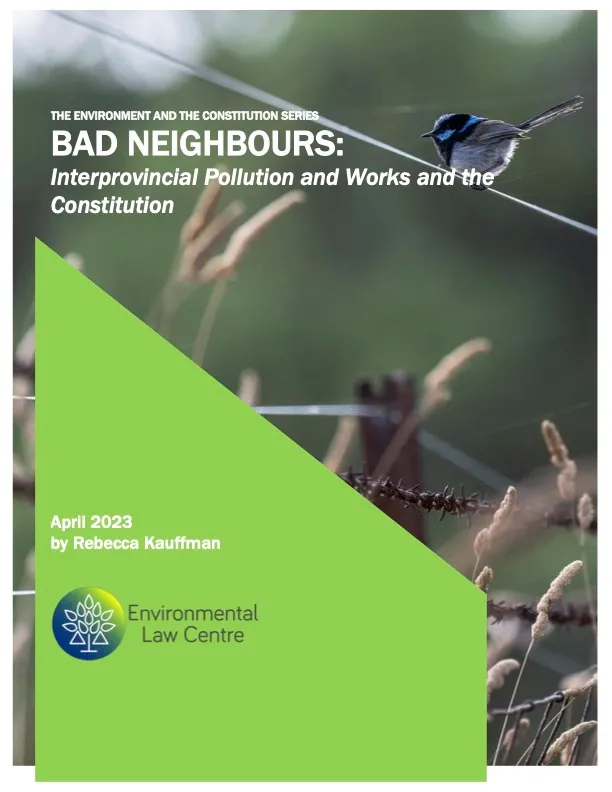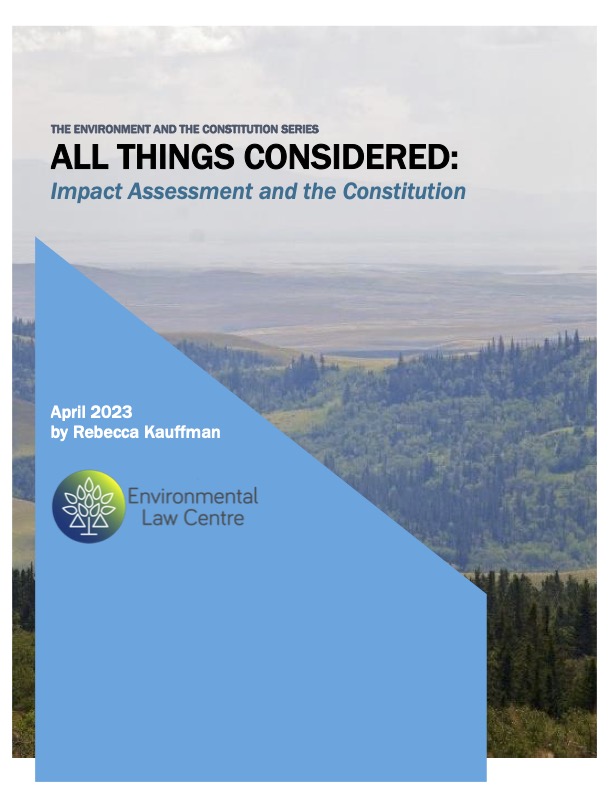The Environment & The Constitution Series:
Interprovincial Matters and Impact Assessment
AN ELC REPORT SERIES
The ELC is pleased to present a series of reports and webinars in relation to the constitutional challenges around environmental management. Underlying this series is the question of whether we can move past ongoing conflict, the battleground of the environment, and seek a more environmentally harmonious approach to management. The first step in answering this question is to understand our current legal state. We began with a backgrounder on Constitutional Law and the Environment and from there move on to topical reports.
This final set of topical reports consider the constitutional jurisdiction to manage interprovincial matters including interprovincial works and pollution and impact assessment including the relatively new Impact Assessment Act. They will also be the subject of an upcoming webinar.
Bad Neighbours: Interprovincial Pollution and Works and the Constitution

Where pollution or works cross political boundaries there is an opportunity for disputes to arise. From the export of bitumen to upstream river pollution, there are disputes about how we can best regulate matters when they cross borders. In Canada, interprovincial works and undertakings are set out in the Constitution Act, 1867 as falling within federal jurisdiction. This applies most readily to projects like the construction and regulation of a railway or pipeline, both of which we will consider below. However, infrastructure is not the only type of interprovincial regulation that engages with issues of constitutional jurisdiction. In particular, we consider how interprovincial pollution is managed and the overlapping jurisdiction over waterways.
This report looks at what happens when our geopolitical boundaries are crossed by pollution and works (e.g., pipelines and transmission lines). As will be discussed, where matters cross provincial or territorial boundaries, the Constitution and jurisprudence elevates the relevance of federal laws. This, in turn, creates a risk of conflict where environmental objectives of different provincial territories come into play. This report sets out the state of the law and highlights some of the issues that arise, first where interprovincial works offend the environmental objectives of a province and second, where interprovincial pollution largely escapes both federal and provincial regulatory accountability and relies on cooperative agreements.
All Things Considered: Impact Assessment and the Constitution

Impact (or environmental) assessment is, at its most simple, an assessment process for large projects which considers the impacts and benefits of a proposed project. The outcome of such an assessment may result in an approval, in conditions on a future approval, or in a refusal.
As Arlene Kwasniak aptly put it, [impact] assessment is “a cornerstone of sustainable development.”[1] She defines it more as a process by which “regulators identify and assess the environmental, social, and economic consequences of proposed projects” to decide whether the project should be approved, and if so, under which conditions.[2] At the federal level, the primary impact assessment legislation is the Impact Assessment Act – the 4th in a series of federal impact assessment laws over the decades.[3] At the provincial level, the Environmental Protection and Enhancement Act is the legislation responsible for impact assessment in Alberta.[4]
The Constitution Act, 1867 does not refer specifically to impact assessment. Instead, the jurisdiction to conduct an assessment is often reliant on whether the project affects interests that otherwise fall under the relevant head of power. For federal interests, this may look like impacts on navigable waters, fisheries, migratory birds or interprovincial matters.[5] At the provincial level, this may look like impacts on public lands, local works and undertakings or impacts on their natural resource powers under section 92A.[6] We will consider both the federal and provincial jurisdiction in turn.
The balance of constitutional authority over impact assessment is also in front of the Supreme Court of Canada, as of writing. In May 2022, the Alberta Court of Appeal released their decision in Reference re Impact Assessment Act in which the majority of that Court advised that the federal Impact Assessment Act was ultra vires federal jurisdiction.[7]The Government of Canada appealed this decision and this was heard at the Supreme Court of Canada in March 2023. While we await a decision from the SCC, we will consider the ABCA decision and all past jurisprudence in light of the federal and provincial impact assessment laws.
Upcoming Webinar: April 20, 2023
Bad Neighbours: Interprovincial Pollution and Works in the Constitution; and
All things Considered: Impact Assessment and the Constitution
Webinar Date: Apr 20, 2023 12:00 PM Edmonton
Register in advance for this webinar:
https://us02web.zoom.us/webinar/register/WN_yGz7aVzuTbWgU3G37LlcHA
After registering, you will receive a confirmation email containing information about joining the webinar.
The first two topical reports consider the constitutional jurisdiction to manage species at risk, the flora and fauna that are at risk of disappearing from the Alberta landscape, and the constitutional overlap of fisheries and water management. The next two look at jurisdiction over the management of toxic substances, and plastics in particular and the regulation of GHG emissions across the country.
Read more about the ELC’s Constitution and the Environment series or to download the backgrounder, or first two reports:
Threatened Jurisdiction: Species at Risk and the Constitution
A Fish Out of Water: Inland Fisheries, Water Management and the Constitution
Drowning in Plastic: Toxins and the Constitution
It’s Getting Hot in Here: GHG Regulation and the Constitution
View past webinar recordings
[1] Arlene Kwasniak, “The Eviscerating of Federal Environmental Assessment in Canada” (31 Mar 2009) ABlawg online: http://ablawg.ca/2009/03/31/the-eviscerating-of-federal-environmental-assessment-in-canada/.
[2] Arlene Kwasniak, “The Eviscerating of Federal Environmental Assessment in Canada” (31 Mar 2009) ABlawg online: http://ablawg.ca/2009/03/31/the-eviscerating-of-federal-environmental-assessment-in-canada/.
[3] Impact Assessment Act, SC 2019, c 28, s 1.
[4] Environmental Protection and Enhancement Act, RSA 2000, c E-12.
[5] Constitution Act, 1867 (UK), 30 & 31 Vict, c 3, reprinted in RSC 1985, App II, No 5, ss 91(10), (12), (29), s 92(10)(a) – (c) & Migratory Birds Convention Act, 1994, SC 1994, c 22.
[6] Constitution Act, 1867 (UK), 30 & 31 Vict, c 3, reprinted in RSC 1985, App II, No 5, ss 92(5), (10) & 92A.
[7] Reference re Impact Assessment Act, 2022 ABCA 165.
ABOUT THE ENVIRONMENTAL LAW CENTRE:
The Environmental Law Centre (ELC) has been seeking strong and effective environmental laws since it was founded in 1982. The ELC is dedicated to providing credible, comprehensive and objective legal information regarding natural resources, energy and environmental law, policy and regulation in Alberta. The ELC’s mission is to advocate for laws that will sustain ecosystems and ensure a healthy environment and to engage citizens in the laws’ creation and enforcement. Our vision is a society where our laws secure an environment that sustains current and future generations and supports ecosystem health.
As a charity, the Environmental Law Centre depends on your financial support. Help us to continue to educate and champion for strong environmental laws, through tools such as our blog and all of our other resources, so that all Albertans can enjoy a healthy environment. Your support makes a difference.
Donate online today
